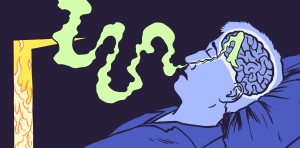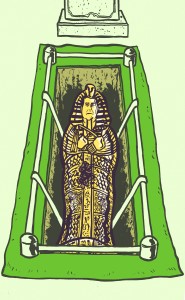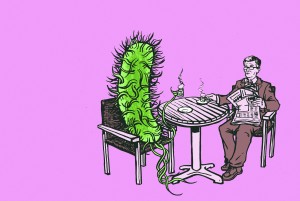WEDNESDAY, 18 JANUARY 2012
The brain-burning smoke alarmScientists from japan have discovered how to wake the hearing impaired in the event of a fire, and in doing so have won themselves the 2011 Ig Nobel prize. The ingenious “Odor Generation Alarm and Method for Informing Unusual Situation” is a standard fire alarm with a difference. Instead of relying on sound as an alert when a hazard is detected, it sprays an unpleasant scent.
In the design of their alarm, the inventors made use of wasabi, a relative of the horseradish. Commonly served with sushi, the condiment is given its pungency by the chemical allyl isothiocyanate. The scientists discovered that this odourous chemical can stimulate pain receptors in the nasal passages. In fact, this stimulation occurs to such an extent that inhalation of the optimal concentration of airborne wasabi can wake a sleeping person in under two minutes. Because smell perception changes during sleep, scent alone is not enough to rouse a person, but the brain-burning sensation produced by wasabi is, since pain receptors continue to function normally during sleep.
The researchers suggest that the alarm could be further developed into an alarm clock or even a doorbell. Nicola Love
It’s a wrap!
Ever wondered what happens after death? For Alan Billis, a taxi driver from Torquay, the answer was on-air mummification in a Channel 4 documentary entitled “Mummifying Alan: Egypt’s Last Secret”. Alan was mummified in the style of 18th dynasty Egyptian pharaohs using techniques developed by the archaeological chemist Stephen Buckley.
Buckley’s team began by making an incision in Billis’s left side and removing all internal organs but the heart, which was thought to be the seat of intelligence and wisdom by the ancient Egyptians. They then packed his body cavity with linen bags and covered him with sesame oil, beeswax, and resin. This mixture protected his skin while he was immersed for five weeks in a bath of concentrated Natron salt. After drying his body, the team wrapped Billis in linens containing family mementos—important tokens for his journey into the afterlife.
CT scans showed that Billis’s body was well-preserved 93 days after starting the mummification process. His body will remain ‘entombed’ for further scientific observation. The team’s success makes Billis the first person to be mummified in this way in 3500 years. Described as “shocking” and “not an easy watch” by reviewers, the documentary sparked considerable controversy. Jordan Ramsey
Could you live on caffeine?
University of Iowa scientists have identified bacteria that can live on caffeine. One, known as Pseudomonas putida CBB5, was even found lolling in a flowerbed on the University campus.
Caffeine is found naturally in more than 60 different plants. Its molecular structure features three clusters of carbon and hydrogen atoms, known as methyl groups, enabling caffeine to resist degradation by other bacteria. Human liver enzymes, which have the task of breaking down caffeine and other drugs, can only get part of the way. This bacterium uses four newly identified digestive enzymes to chop down caffeine into a carbon dioxide and ammonia molecule. Through this process, the bacterium harvests energy, achieving things with caffeine that humans are unable to.
Ryan Summers, the doctoral researcher who led the study, said no previous research has located caffeine consumption in any other microbe species. He and his collaborators also noted that this finding could someday have implications outside of the highly caffeinated Petri dish.
The bacterial digestive enzymes could be used to develop new medications to treat heart arrhythmias or asthma, or to boost blood flow. They could also be used in large scale processes to help break down excess caffeine, which is often generated as a by-product of decaffeinated coffee and tea processing. Mariana Fonseca



